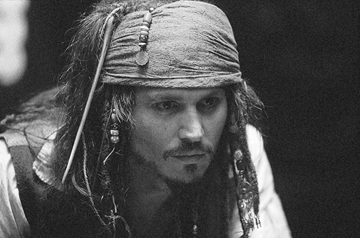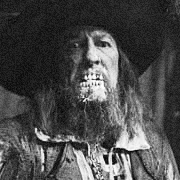Most will compare Pirates of the Caribbean: The Curse of
the Black Pearl with the Disneyland ride of the same name.
While there are many visual cues taken from Uncle Walt's animatronic
wonder, Gore Verbinski's film owes more to the live action adventure
films that Disney put out in the years before the Jolly Roger
was flown and E Tickets were collected.
The story starts with a star-crossed couple who meet as children
and grow up together yet apart. Before the sighing and cow eyes
become too much, the loopy Captain Jack Sparrow comes to town.
The three leads tangle until the real trouble comes to town
in the form of the menacing pirate ship, The Black Pearl.
Captain Jack comes from the Mary Poppins school of Disney catalyst
characters. More colorful than anything else in the picture,
their arrivals signal an adventure is close behind and, sure
enough, The Pearl's Captain takes our fair maiden hostage during
a masterful sequence of pillaging.
Johnny Depp's performance as Captain Jack Sparrow comes as
yet another triumph in a career of self-topping turns. In fact,
it wouldn't be sad or surprising if this is the role Depp is
remembered for 20 or 40 years from now. Like many of Depp's
other performances, Sparrow is simultaneously over-the-top with
a capital Top as well as human and real. It's something Dr.
Hunter S. Thompson has done his entire life—which is why
Depp played him so well too. Sure, he's a character, but your
local dive bar is filled with less believable characters than
any of Depp's.
As leads both Orlando Bloom and Keira Knightley are adequate.
They really just have the thankless task of carrying the narrative
and looking pretty, which means they can't have as much fun
as Depp is obviously having. Their roles are the same as Peter
Riegert and Karen Allen's in Animal House. They get to have
perfectly enjoyable story scenes about their relationship and
the plot while everybody waits for Belushi. Fortunately, Verbinski
remembers that even if the job is thankless, it has to be done.
If you don't have the romantic couple's plot to kill time between
Harpo appearances, you end up with Love Happy or a Jim Carrey
picture.
Bloom's blacksmith is written as a good foil against Captain
Jack (both literally and figuratively) who one can believe will
come around in the end. On the other hand, Knightley's rich
little tomboy comes off as about the only sour note in this
whole picture.
At some point it was decided that all female lead characters
absolutely have to despise the trappings of femininity and be
real independent go-getters who will stop at nothing and do
all the things the men do and more. While the feminist intention
is all fine and dandy, the endless ‘feminine pragmatism’
bit has been played out. Fortunately there are no “men
can't stop and ask for directions” jokes but one feels
that's just because they mercifully got cut. Knightley has the
only Arnold-style dispatch line, and it falls flatter than the
many “it may say it's PG-13 but it should be rated Arrrrrr”
jokes that will surely flit about this picture.
As the evil Captain Barbossa, Geoffrey Rush finds a fine balance
of villain and victim. He plays Barbossa as a man who was already
starting to turn from within when the curse was levied, and
then years of being forced to go on living when he cannot truly
live has caused him to rot so completely that his skin hangs
like that of sun-baked fruit.
These days the standard quote from a family filmmaker goes
something like, “Well, of course, the movie and story are
mostly for kids but we put in some jokes that only the adults
are gonna get that just go right over the kids' heads.”
It is as if they think there is no common ground that all ages
can share when it comes to entertainment. Pirates finds
that common ground and commands it, just as Captain Jack commands
every boat and scene he boards.
Kids don't want to watch “Kids' movies”; they want
to watch the most grown-up movie they can get away with seeing.
Pirates is a grown-up movie with nothing in it to be
found objectionable for the young ones. The Secret of the
Black Pearl comes to port on levels that, while some kids
might not get all of them, surely many adults won't either—or
even care if they do.
Although it works as a fun adventure picture, Verbinski has
a little more up his sleeve. There are surprisingly complex
story dialogues about honor and quality of life. When Will gets
infuriated when told of a relative's pirate past, Sparrow reiterates
that he was a pirate “and a good man” adamantly insisting
that these are two very separate qualities. Invoked many times,
The Pirates Code as explained in the picture is never broken,
but even if it is they are really more like guidelines than
rules.
Following that code, Captain Jack is marooned on a small atoll
with a pistol and one shot. The thinking is that the stranded
can use that one shot to end things when the hunger and sun
become too much. On the flip side of that is the spectral crew
of The Black Pearl, who cannot enjoy their plunder thanks to
the curse. Barbossa single-mindedly thinks of all the apples
he will eat when the curse is lifted, making his rotted apple
face all the more poignant. No matter how miserable they are,
they can't even take the option that Captain Jack has on the
island.
With that in mind, Verbinski still keeps things light. The
picture never truly teeters into the dreaded Action-Comedy bin
but stay right about at Light Action like Raiders of the
Lost Ark or Swiss Family Robinson. The well-choreographed
sword fights look like they are being improvised and while they
are peppered with some verbal thrusts and parries, it's mostly
believable and fairly unquotable, making it the best kind.
The effects also play out right; very few showy effect moments,
mostly just matter-of-fact 'the effects are needed here' type
action. The visual references to the ride are played in such
a way that, except for the knowing laughter, someone out of
the loop won't notice they are missing something. Even the way
the song is slipped in doesn't feel forced, and thankfully there
was not the modern cover by Aerosmith behind the credits.
Verbinski slips in a few other nods like a few stolen gags
from The Good, The Bad and The Ugly, and it can't be
a coincidence that this Disney picture about ghost pirates prominently
features an antique bed warmer. Neither moment is oversold;
they are just there. In fact, for a picture with amazing set
design it is thankfully lacking in showy set piece shots.
Pirates of the Caribbean: The Secret of The Black Pearl
may be the first film of the year that could have some legs
at the box office and rightfully so. This picture is the first
step in the right direction Disney has taken in about 10 years.
Hopefully they will start to remember how these things used
to be done and recapture that magic they had when Walt still
ran the show, when a family picture meant great for the whole
family, not pandering to as many demographic groups as possible.
